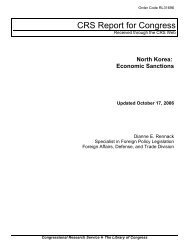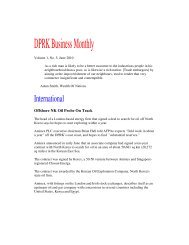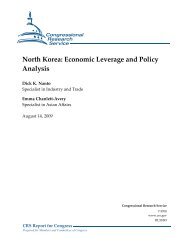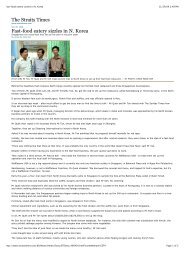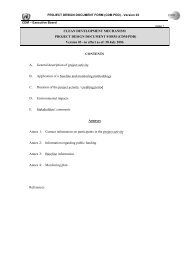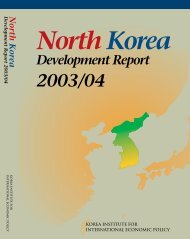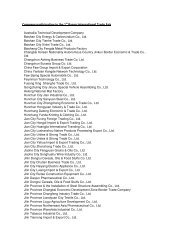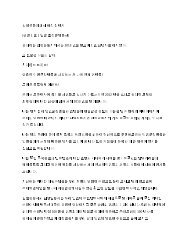North Korean Policy Elites - Defense Technical Information Center
North Korean Policy Elites - Defense Technical Information Center
North Korean Policy Elites - Defense Technical Information Center
Create successful ePaper yourself
Turn your PDF publications into a flip-book with our unique Google optimized e-Paper software.
to the throne. The State Council usually consisted of fewer than fifty noblemen, including three<br />
supreme counselors, two royal personal assistants, six ministers, chief inspectors, military<br />
leaders, and some provincial governors.<br />
Any policy recommendation made by the State Council was always based on unanimous<br />
consent. But, often arm-twisting and political intrigue were used to arrive at that unanimity. Then,<br />
policy recommendations were submitted to the king for his approval. As a rule, the essence of all<br />
major foreign policy and national security decisions was to hand the issue to the Chinese<br />
Imperial Court for its own deliberation and final approval, which was only natural because Korea<br />
was, after all, a tributary state of the Middle Kingdom. That was the decision-making process<br />
followed by <strong>Korean</strong> rulers when they had to make up their mind as to how to handle shipwrecked<br />
Western sailors who washed on <strong>Korean</strong> shores or whether or not and how to normalize<br />
relations with Japan and the Western powers in the mid-19th century.<br />
The Japanese colonial rule that lasted for thirty-five years contributed heavily to the<br />
dislocation of the traditional <strong>Korean</strong> political system, its values, institutions, informal influence<br />
networks, and policy-making mechanisms. Although the Japanese-installed Government-General<br />
of Chosen was not empowered to deal with foreign policy matters, its impact on subsequent<br />
institutional development in Korea was enormous, for it was the Japanese who for the first time<br />
set up a modern, efficient bureaucracy in Korea, inculcated many of the post-war <strong>Korean</strong><br />
administrative beliefs, and left behind thousands of Japanese-trained <strong>Korean</strong> administrators,<br />
managers, and officials after their forced and abrupt departure in August 1945.<br />
The amalgamated communist party-state formed under Soviet tutelage after the liberation,<br />
and cemented in the trials and tribulations under Kim Il Sung’s leadership during and after the<br />
<strong>Korean</strong> War, was a localized replica of the Soviet communist party-state system, exhibiting<br />
many features of the typical Stalinist political system and bureaucratic regime, emphasizing the<br />
one-man-centered communist party monopoly rule, mass mobilization politics, repressive<br />
security apparatus, unanimity, and centralism in policy decision-making.<br />
Kim Il Sung founded a dynastic monarchy in the late 1940s, although officially he<br />
proclaimed the establishment of the Cabinet-based parliamentary republic in September 1948,<br />
which was later recast as a presidential republic in the course of the constitutional revision in<br />
1972. For a long time, the President cum Great Leader relied on his personal Secretariat to set<br />
national security priorities and formulate foreign policy goals. As the issues grew in complexity,<br />
he began to turn for advice and support to the other senior leaders of the <strong>North</strong> <strong>Korean</strong><br />
government, most of whom were his former revolutionary comrades-in-arms. That collective<br />
consultative process was officially legitimized when the 1972 constitutional reform set up the<br />
IV-5



